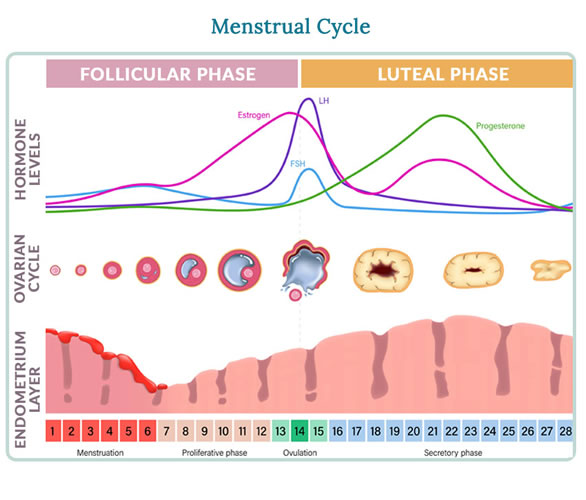Hormones & the Menstrual Cycle

There are many events that take place during the average 28-day menstrual cycle. The 3 main phases are the follicular phase, ovulatory phase, and luteal phase. You may have learned that there are 4 main phases beginning with menstruation followed by follicular, ovulatory, and luteal. This is also accurate because menstruation and follicular growth occur simultaneously. Let’s briefly discuss hormones and each phase.
There is a region of your brain called the hypothalamus that plays a critical role in many functions, but we will focus on releasing hormones. The hypothalamus produces the most important hormone for reproduction and it’s called gonadotropin-releasing hormone, or GnRH. GnRH stimulates a small gland at the base of your brain called the pituitary gland to produce follicle-stimulating hormone (FSH) and luteinizing hormone (LH) which allows the ovaries to produce estrogen and progesterone. Each phase of your menstrual cycle is regulated by one of the hormones mentioned and, without proper timing and concentration, the ability for you to conceive is impacted.
Estrogen causes your uterine lining (endometrium) to thicken each month in preparation for the implantation of an embryo. Progesterone then aids in further endometrial development to support pregnancy. If fertilization does not take place in the fallopian tube and implantation does not occur, the endometrium is shed. This process is known as menstruation or the menstrual “period” and marks day 1 of your menstrual cycle.
Estrogen causes your uterine lining (endometrium) to thicken each month in preparation for the implantation of an embryo. Progesterone then aids in further endometrial development to support pregnancy. If fertilization does not take place in the fallopian tube and implantation does not occur, the endometrium is shed. This process is known as menstruation or the menstrual “period” and marks day 1 of your menstrual cycle.
Usually 14 days into your cycle (mid-cycle) ovulation is prompted by high estrogen levels. Unlike FSH, high blood estrogen levels have positive feedback on LH. This surge in LH paves the way for a complex set of events to take place that allows for the final stage of egg maturation and rupturing of the dominant follicle. Follicle rupture prompts release of the mature egg into the fallopian tube where sperm would meet it for fertilization. If fertilization does not take place within 24 hours, the ovulated egg will die. Ovulation generally takes place 28-36 hours after the LH surge.
Once ovulation occurs, the luteal phase begins around day 15 of your cycle and lasts approximately 12-15 days. Recall that during ovulation, the egg bursts from the follicle, but the ruptured follicle remains on your ovary. The site of the egg release transforms into a structure called the corpus luteum (CL). The CL secretes progesterone and estrogen to support embryo implantation if fertilization occurs.
If fertilization is successful in the fallopian tube, the egg is now called a zygote and will undergo cell division processes for a few days. After dividing into multiple cells, the zygote is now referred to as an embryo. Between day 5-7, the embryo is transported to the uterus, and is now a blastocyst. When the blastocyst hatches out of its shell, called the zona pellucida (ZP), and implants successfully, it will release the hormone human chorionic gonadotropin (hCG).
hCG keeps the CL alive throughout your first trimester for endometrial support until the placenta forms around 10-12 weeks. If implantation does not take place, the CL will die, causing estrogen and progesterone levels to decline. The hormone-dependent endometrium undergoes degeneration and sheds, which initiate your next menstrual cycle.
Testosterone is the key hormone in male reproduction. Similar to female reproduction, the hormones FSH, and LH play a critical role. LH causes the testes or testicles to produce testosterone; whereas, FSH aids in the production and maturation of sperm.
When ejaculation occurs during intercourse, approximately 100 million sperm are released and must swim through the vagina, cervix, and uterus to meet the egg in the fallopian tube. Although hundreds of millions of sperm enter the vagina, only a thousand or so make it to the fallopian tube. This is normal as sperm are the smallest cells in the human body and undergo quite the journey to meet the egg.
